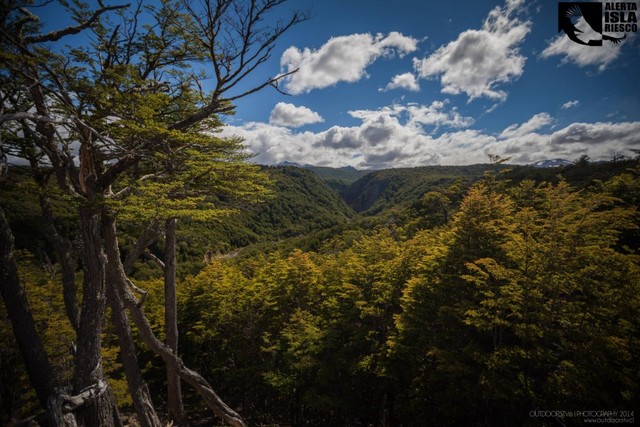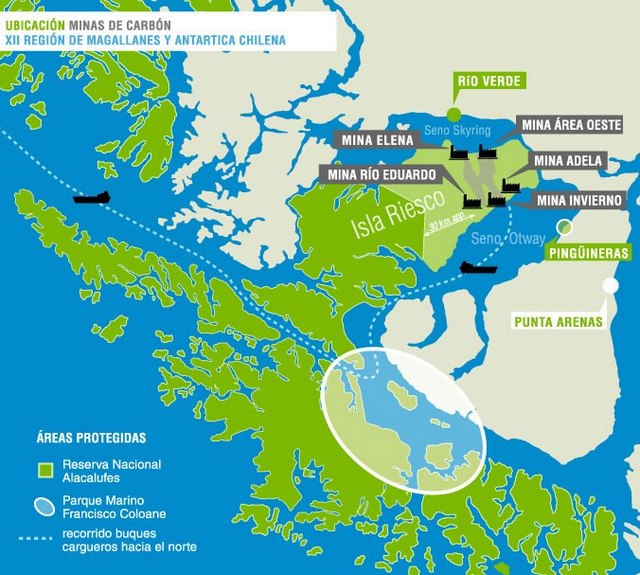Thursday, April 25, 2024
News and Views from the Global South
Environment
Coal Mine Threatens Ecological Paradise in Chile’s Patagonia Region

Humpback whales and dolphins are part of the rich habitat of the Otway gulf, in the Magellan Strait, near the Invierno mine on Riesco Island in the southern Chilean wilderness region of Patagonia. Credit: José Antonio de Pablo/ Riesco Island Alert
- An open-pit coal mine in the southern island of Riesco, a paradise of biological diversity in Chile’s southern Patagonia wilderness region, is a reflection of the weakness of the country’s environmental laws, which are criticised by local residents, activists, scientists and lawmakers.
Riesco, the country’s fourth-largest island, at the southern tip of South America, and the waters around it, is home to many species, such as the humpback whale, four kinds of dolphins, elephant seals and penguins, 24 species of land mammals and 136 birds.
“I will not leave. But I see the drastic changes,” a worried Gregor Stipicic, one of the island’s 150 inhabitants, told IPS by telephone from Riesco.
Gregor, 36, is the youngest of three Stipicic siblings who own a 750-hectare farm where they raise about 6,000 sheep, which are now threatened by dynamite explosions.
Gregor, a surgeon by profession, has been living on the farm since 2006, when he took charge after the death of his father. His grandfather, a Croatian immigrant, arrived to the island in 1956, drawn by its fertile soils.
Riesco Island is 5,000-sq-km in size and is 3,000 km south of Santiago, in Magallanes, the country’s southernmost province.
The local inhabitants live and work on 30 farms, which mainly raise sheep.
One-third of the island’s territory is within the Alacalufes National Reserve, one of the largest in Chile, covering 2.6 million hectares of wilderness that forms part of the country’s protected areas.
The “mina invierno” or winter mine, the largest open-pit coal mine in the country, belongs to the Riesco Island Mining Company, owned by the Chilean companies Copec and Ultramar, which invested 600 million dollars in the mine, and have four other deposits on the island, so far inactive.
The aim is to exploit, for 12 years, reserves of 73 million tons of sub-bituminous coal, of low calorific value and high heavy metal content. The coal is sold to the Huasco, Tocopilla, Mejillones and Ventanas thermoelectric plants in north and central Chile, and exported to China, India, Brazil and other countries.
The steady decline in international coal prices affected the company’s plans, which temporarily decreased production and cut its payroll.

Lengas (Nothofagus pumilio) and Antarctic Beech (Nothofagus antarctica) seen on Riesco Island, in Chile’s Patagonia wilderness region, which is threatened by coal mining. Credit: Claudio Magallanes Velazco/Riesco Island Alert
To open the Invierno mine, 400 hectares of native woodland were cut, a lake was dried up, and the functioning of the water in the surrounding area was modified. It currently has three sterile waste dumps, each one 60 mts high.
“Everything is becoming polluted. Some 1,500 hectares of land will be directly affected, including 500 metres of open pit which has already reached 100 of the projected 180 metres in depth,” said Ana Stipicic, spokesperson for the social and ecological movement Riesco Island Alert.
“The last report on pollution we made was on the impact on the Chorrillo Invierno Dos River. Now we learned that the Cañadón and Chorrillo Los Coipos Rivers were also polluted. There are settling ponds to remove matter from wastewater, but they don’t work,” the activist, who is Gregor’s sister, told IPS in Santiago.
She said that the rivers affected a wetland and “along the shore there are enormous pieces of coal. The mining port and the crushers that crush the mineral throw charcoal into the sea. Nobody has studied this.”
Ana Stipicic said particles in the air “fall on the surrounding grazing lands, woods and water bodies where there is rich fauna.” She added that the mining activity “has caused huge movements of wildlife, from woodpeckers to huemul deer and capybara.”
Biologist Juan Capella, from the Yubarta Foundation, complained that the shipping of coal through the Otway gulf, the Gerónimo channel and the Magellan Strait has affected humpback whales and dolphins that live in this area, where the Francisco Coloane Marine Park is located.
“There are reported cases of collisions of cargo ships with whales. The more coal that is transported and the heavier the ship traffic in such a narrow channel, the higher the chances of collisions and deaths of whales. The latest recorded case occurred in March, when a ship ran into a whale and killed it,” he told IPS from Punta Arenas, capital of Magallanes province.

Map of the location of coal mines on Riesco Island at the southern tip of Chile. Credit: Riesco Island Alert
Climate specialist Nicolás Butorovic said that during the Environmental Impact Assessment of the Invierno mine, “we proved that the modelling was wrong with respect to settleable particulate matter. They predicted 60 micrograms per day while the stations measured up to 158.”
The company had stated that it would not use dynamite explosions since they sought sustainable mining. It also claimed that winds in the area averaged 39 kilometres per hour when in fact they can reach up to more than 180 kilometres per hour.
Fernando Dougnac, head of the organisation of environmentalist lawyers FIMA, filed legal action which brought the explosions to a halt.
Dougnac told IPS in Santiago that in his legal presentation he included veterinary records from the year 1998, showing that during breeding season, sheep are highly susceptible to noise, to the point that workers are asked to stay out of the areas where the sheep are mating or raising young.
“We expect the explosions to be stopped during those months. The Invierno mine needs to cut operating costs, so they will insist on making detonations the four times a week that they are allowed,” said Ana Stipicic.
The national director of Greenpeace Chile, Matías Asún, told IPS that the mining company “deceived the population and disregarded the regulations to later be allowed to use dynamite explosions.”
In his opinion “Chile’s environmental authority operates on the basis of economic and commercial criteria. Their official discourse is not the protection of the environment but the protection of investment and the environment.”
He said “it is anachronistic that in a country where renewable energies are experiencing remarkable growth at a global scale and coal is in decline, on top of the many territorial conflicts generated, a subsidy is granted violating de facto environmental regulations and the commitments that the own company made to the community.”
“Riesco Island is not sustainable without cutting costs with environmental impacts,” he stressed.
Independent legislator for Magallanes province Gabriel Boric told IPS that the company presented the coal mining project in a fragmented manner to obtain approval.
“That a project be allowed to be presented by parts, so that its environmental impact cannot be assessed integrally, is one of the main weaknesses of our environmental protection system, which must be remedied by means of reforms,” he said.
-
Sabe_Moya

 Print
Print



